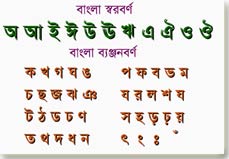MOVEMENTS FOR LANGUAGE
 Bangla is the official language of Bangladesh. It is also spoken in West Bengal. Bangalees protected Bangla from the clutches of Pakistani oppressors in 1952 by preventing Urdu from being the state language of East Pakistan where a vast majority of people spoke in Bangla. Bangalees had to sacrifice lives for their mother tongue on 21st February, 1952. 21st February being declared International Mother Language Day by UNESCO, Bangla reached the peak of maturity. The following persons worked hard for bringing this international recognition to Bangla. Bangla is the official language of Bangladesh. It is also spoken in West Bengal. Bangalees protected Bangla from the clutches of Pakistani oppressors in 1952 by preventing Urdu from being the state language of East Pakistan where a vast majority of people spoke in Bangla. Bangalees had to sacrifice lives for their mother tongue on 21st February, 1952. 21st February being declared International Mother Language Day by UNESCO, Bangla reached the peak of maturity. The following persons worked hard for bringing this international recognition to Bangla.
 Rafiqul Islam, Abdus Salam, Albart Vinzon, Carman Cirstobal, Zason Morin, Susan Hozinos, Dr. Calvin Chow, Nasrin Islam, Rinata Martins Karuna Zoshi. (The picture on left - The famous artists are painting our great language fighters picture before International Mother Language Day). Rafiqul Islam, Abdus Salam, Albart Vinzon, Carman Cirstobal, Zason Morin, Susan Hozinos, Dr. Calvin Chow, Nasrin Islam, Rinata Martins Karuna Zoshi. (The picture on left - The famous artists are painting our great language fighters picture before International Mother Language Day).
Evolution
Bangla's direct ancestor is a form of Magadhi Prakrit or Middle Indo-Aryan which descended from Sanskrit or Old Indo-Aryan. Bangla evolved mainly from Sanskrit. Also Hindi, Urdu, Farsi, English--all contributed lots of words and terms to form this language.
Back to the top
The Origin of Bangla Alphabet
 Bangla alphabet originated from Brahmi alphabet of the Asokan inscriptions. The Bangla script in its present printed form took shape in 1778 when printing types were first cast by Charles Wilkins. There still remained a few archaic forms and these were finally replaced in the middle of the nineteenth century. Bangla alphabet originated from Brahmi alphabet of the Asokan inscriptions. The Bangla script in its present printed form took shape in 1778 when printing types were first cast by Charles Wilkins. There still remained a few archaic forms and these were finally replaced in the middle of the nineteenth century.
Back to the top
The Oldest Records
For old Bangla the only record is Charjapad discovered from a palace in Nepal by Haraprasad Shastri. It is a collection of the oldest verses thought to be the oldest records of Bangla literature. The language of Charjapad is basically vernacular, but at the same time it is also something of a literary language.
Two Styles of Bangla Language
Bangla at the present day has two literary styles. One is called "Sadhu Bhasha" and the other "Chalit Bhasa". The former is the traditional literary style based on Middle Bangla of the sixteenth century. The later is practically a creation of the present century, and is based on the cultivated form of the dialect and day-to-day talks. The difference between the two literary styles is not very sharp. The vocabulary is practically the same. The difference lies mainly in the forms of the pronoun and the verb. The Sadhu Bhasa has the old and heavier forms while the Chalit Bhasa uses the modern and lighter forms. The former shows a partiality for lexical words and for compound words of the Sanskrit type, and the latter prefers colloquial words, phrases and idioms. The Chalit Bhasa was first seriously taken up by Pramatha Chawdhury at the instance of Rabindranath Tagore during the early years of the first World War. Soon after Tagore practically discarded Sadhu Bhasa, and Chalit Bhasa is now generally favored by writers who have no particular fascination for the traditional literary style.
Back to the top
International Mother Language Day
The UNESCO has declared 21st February as The International Mother Language Day to be observed globally in recognition of the sacrifices of the Bangla language martyrs who laid their lives for establishing the rightful place of Bangla. The proclamation came in the form of a resolution unanimously adopted at the plenary of the UNESCO at its headquarters in Paris in November 1999. In its resolution the UNESCO said-' 21st February be proclaimed International Mother Language Day throughout the world to commemorate the martyrs who sacrificed their lives on this very day in 1952’.
It is a great tribute and glowing homage paid by the international community to the language martyrs of Bangladesh. The genesis of the historic Language Movement which ensued since September 1947 with the students in the vanguard backed by intellectuals, cultural activists and patriotic elements was the first spurt of Bangalee nationalistic upsurge culminating in the sanguinary events of February 21, 1952 and finally leading to the war of Liberation in 1971.
The UNESCO in its resolution said-the recognition was given bearing in mind that all moves to promote the dissemination of mother tongues will serve not only to encourage linguistic diversity and multilingual education but also to develop fuller awareness about linguistic and cultural traditions throughout the world and to inspire solidarity based on understanding, tolerance and dialogue.
Henceforth UN member countries around the world will observe 21st February as the International Mother Language Day. The historic 21st February has, thus, assumed new dimension. The sacrifices of Rafiq, Salam, Jabbar, Barkat and other martyrs as well as of those tortured and repressed by the then authoritarian government of Pakistan for championing the cause of their mother tongue have received now a glorious and new recognition by the November 1999 resolution of the UNESCO.
Countries who gave support to the proposal of Bangladesh Govt. for declaring the 21st February as The International Mother Language Day are Banin, Bhahama, Balaroush, Comoros, Chili, Dominic Republic, Egypt, Gambia, Honduras, Italy, Iran, Micronesia, Oman, The Philippines, Papua Newgini, Pakistan, Paraguay, Russian Federation, Sir Lanka, Saudi Arabia, Surinam, Slovakia, Vanuatu, Indonesia, India, Ivoricost , Lithuania, and Malaysia.
Back to the top |

